Sorry that you are having the same problems. Logically it seems like heat should dissipate through the fabric back pretty easily, but it did get me thinking - my Claravox is right next to an AC vent - in fact I turn off the AC sometimes when I'm playing because I find the noise/blowing air annoying. So it's getting some extra cooling throughout the day.
Actual information on Claravox
Claravox Repair
Jeff (ContraDude) came by today with his serial #00218 Claravox. Initially it was acting up, squeaking and chirping, but mostly it was silent. Then after a minute or two it started acting like one would expect a properly functioning Theremin to behave. We opened it up to do the recommended fix that Moog prompts its customers to attempt. I also took some pix, made some measurements, demoed it some, and we discussed the instrument. I wanted to share what we learned with the folks here at TW.
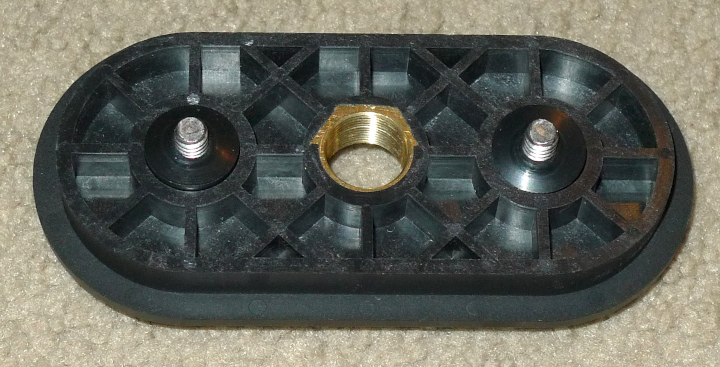
When putting it on a short mic stand, I noticed the plate that mates to the bottom of the Claravox looked like it was made out of plastic, which was a surprise. If true, I guess I'd worry about it cracking and such under stress, like if it got knocked over. It has some kind of speckled paint on the other side that makes it look like metal.
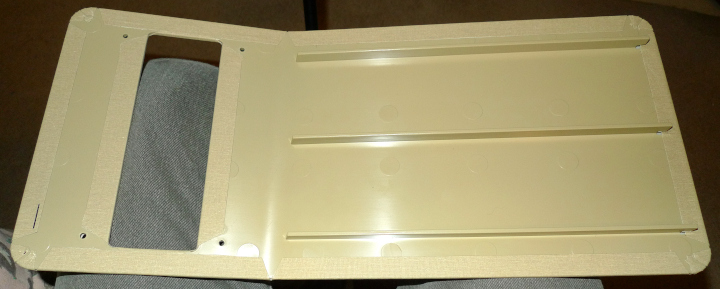
I removed the 4 back screws as Moog instructed and removed the back. It's one big piece of fairly thin injection molded plastic, which was another mild surprise, I don't know why. But there's definitely no heat ventilation going on here, and it probably can't take a lot of punishment.
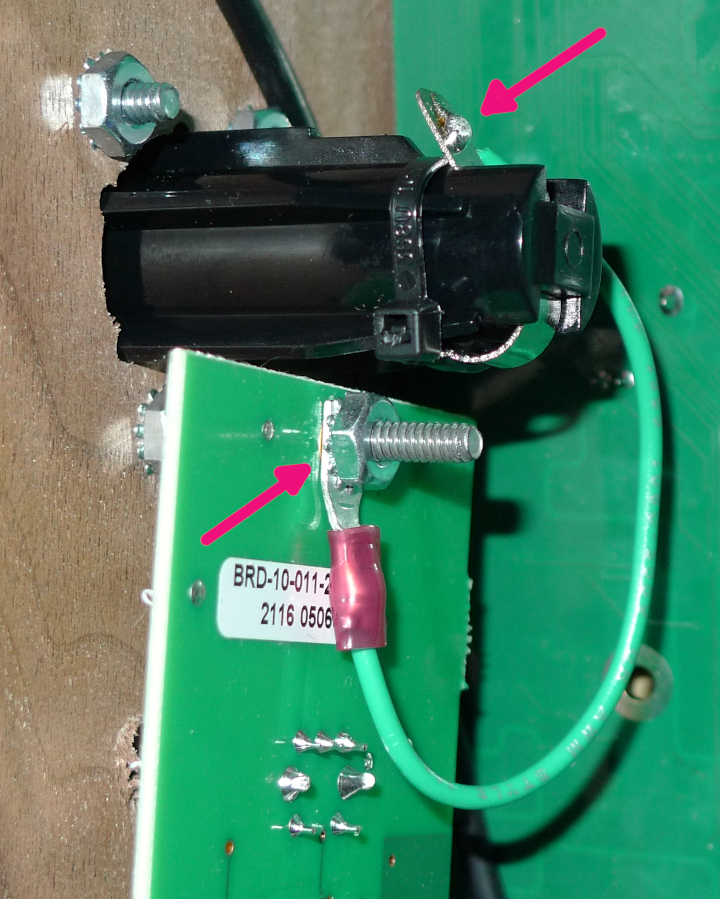
Getting down to business, I checked the connections between the antennas and the oscillator boards. It seems Moog has installed wires between the oscillator boards and the end electrical spring connector. The top end of the wire is soldered, the bottom end is a crimped spade lug. There is no star washer between the spade lug and the PCB. We were tempted to add one to guarantee connectivity, but had second thoughts and decided not to. The screws and nuts and stuff were very tight from the factory, almost scary tight. Anyway, if your Claravox doesn't have these wires, I would strongly recommend you fashion some of your own and install them.
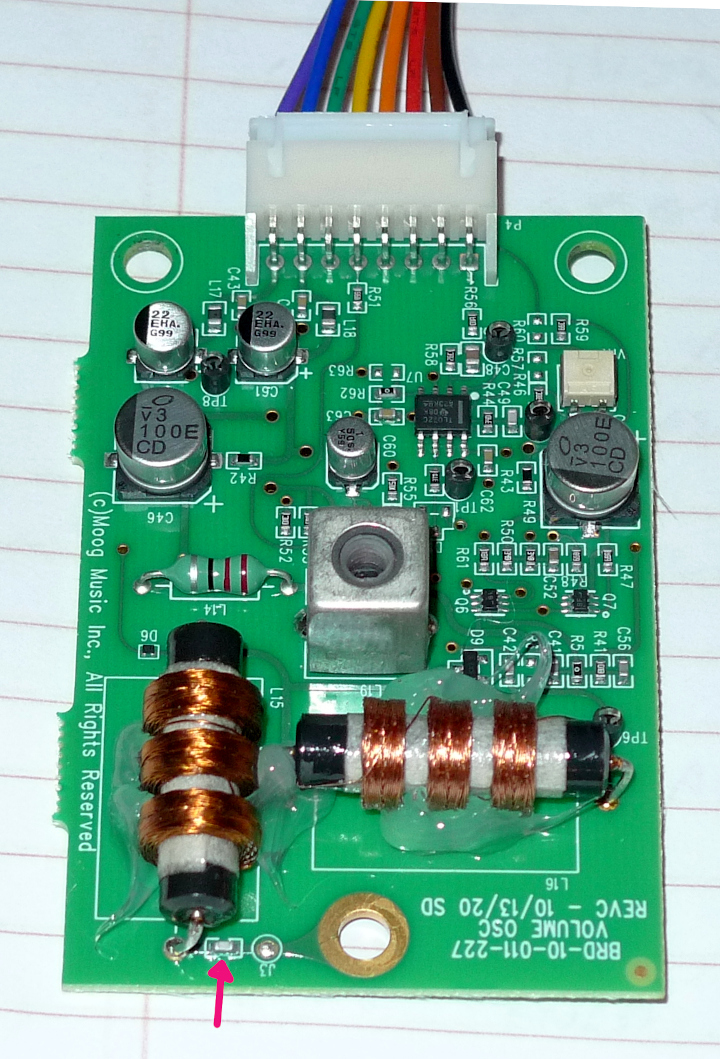
Above is the volume oscillator board. The arrow indicates a small capacitor in series with the antenna. I wonder what it's voltage rating is (I would worry about ESD here)? I tried to measure it but my meter was inconsistent, maybe 185pF? The coils in series measured 7.36 mH total with a DCR of 26.8 ohms total. [EDIT] Also notice the added silicone splooge to the inductors to affix them, probably a good move.
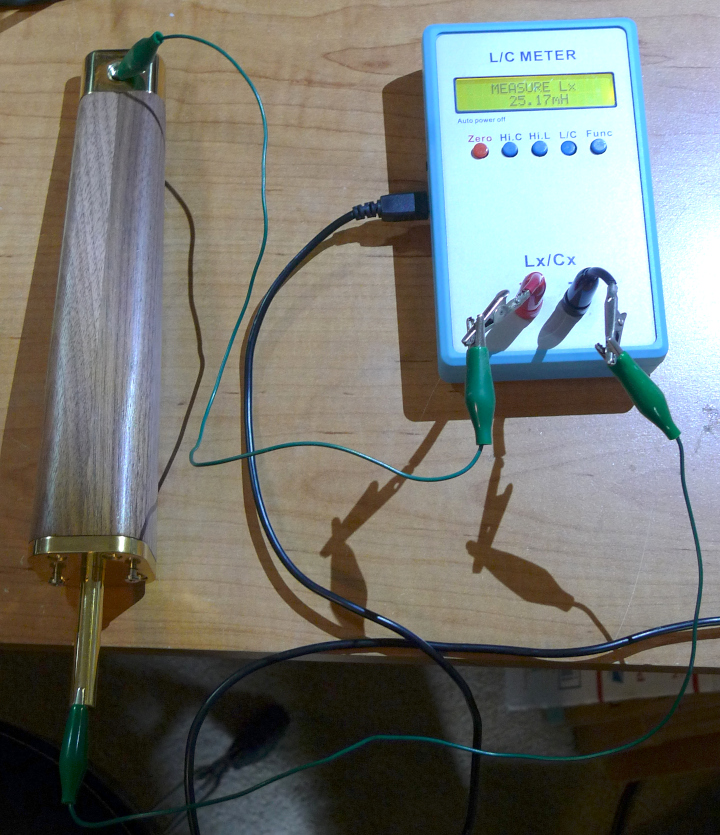
Here I'm measuring 25.17mH in the pitch arm inductor, I forgot to measure the DCR.
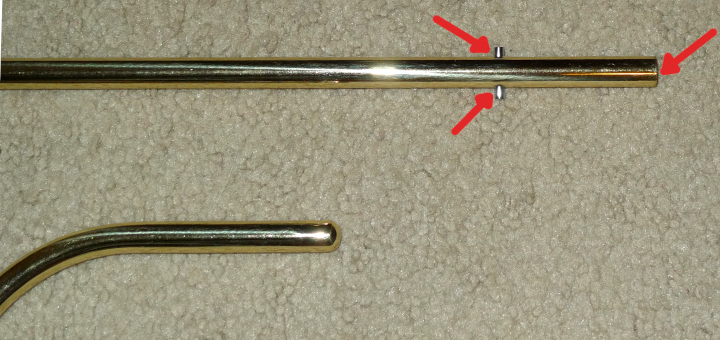
The above shows the end of the volume loop, which we believe was the culprit. The arm itself is lacquered or otherwise non-conductively coated, I couldn't get an ohms reading on it anywhere except for inside the open end. Even the locking pins are coated and non-conductive. What seems to be really critical though is the very end isn't conductive either. If this were my instrument I'd take some sandpaper to the very end face and expose the metal, so that it makes proper contact with the spring connector inside the Claravox (which is connected to the new green wire). Jeff and I were able to get the Claravox to act up by rotating the volume antenna, a clear sign of poor connectivity here.
Using my high voltage probe with ~2pF load, I measured 105Vpp @ 322kHz on the pitch antenna, and 60Vpp @ 531kHz on the volume antenna, considerably higher swings than quoted by the Moog engineer, which is good.
Jeff and I performed a calibration on the unit, then sat down to play it some. It's been a while since I owned a "real" Theremin but the fields seemed to behave very much like my old Etherwave standard kit, with the "brightness" and "wave" knobs. I had high hopes for the pitch antenna "response" knob that only functions in "modern" mode, but it didn't have as much range as I would have liked. Turning it clockwise expands the note spacing somewhat, but I could only get it to do maybe 2/3 of an octave or so open/closed hand with the knob fully clockwise, and I prefer about half this. The pitch null point seemed to require a lot of touch-up, but that seems to be par for the course with analog Theremins, and we were switching modes a lot, where the null point doesn't track and so really goes out of whack.
The volume field knobs had to both be almost fully clockwise and I had to play with my fingers inside the loop to get a sufficiently snappy volume knee. No provision for reversing the volume sense, but we knew that.
I see even more clearly now why pitch quantization is offered, and not full fledged pitch correction, as the latter demands some sort of absolute pitch feedback, whereas the former can be "felt" while playing, and can be used as a special effect. Moderate levels of quantization let vibrato through too. I believe it indeed could be used as a pitch training aid.
There are no encoders on the Claravox, instead potentiometers are digitized. This is a pet peeve of mine because potentiometers have state that gets in the way. For instance, after you change the voice preset via the Timbre knob, to adjust the brightness you have to rotate the knob a little for it to "catch" and start doing its job, and before this the knob indication has absolutely no correlation to the setting. It's a cheap but awkward way to get a bunch of knobs on a panel. Encoders have no troublesome state, but they're harder to interface correctly.
There seem to be many parameters inaccessible via the front panel, which is another pet peeve. A fairly shallow dive for that many knobs IMO (four of which don't even function in "traditional" mode).
The delay at maximum was around one second, and was fun to play around with, but I would very much prefer reverb.
In "traditional" mode the tuner output provided a fairly mellow sound, which one would hope as it makes the tuner's job easier. But in "modern" mode it followed the timbre of the voice too closely, so on preset 6 it sounded like a buzz saw.
They really should have tried to make the octave register switch work in "traditional" mode. This was possible on the EPro, why not the Claravox? It's an incredibly useful knob IMO.
The craftsmanship of the case was quite nice, really pretty walnut and brass, the speaker grill covering more tasteful and flat, and less "burlapy" than I expected. Overall perhaps a bit large though, there's a lot of air inside.
It's always great fun seeing Jeff, it was a lot of fun too demoing his Claravox. I hope it continues to function well!
dewster (Eric): It's always great fun seeing Jeff, it was a lot of fun too demoing his Claravox. I hope it continues to function well.
As always, it was GREAT fun seeing you, you’re EXTREMELY helpful.
I got home and immediately reassembled the Claravox and thought I’d make a video to demonstrate the problem with the volume antenna. Well, everything worked as expected - but then STOPPED. 😡 The Claravox is, once again, dead in the water. However, as we identified the problem with antenna connectivity, I thought I’d fiddle with that a bit more. I am now 99.9% confident that this is the problem. After I tried all other possibilities and couldn’t get a sound out of the Claravox, I finally decided to lightly sand the blunt end of the volume antenna - the end that is inserted into the instrument. When inserted all the way in, no audio is produced (obviously due to no conductivity); HOWEVER, when I lightly touch the blunt end of the volume antenna to the exterior brass plate, audio usually comes through loud and clear. This also sometimes seems true if that same blunt antenna touches something just inside the brass plate. I’ve been able to replicate this multiple times.
So, the next step is to determine specific spot on the antenna is supposed to come in contact with the Claravox. At the moment, I can’t determine if it’s on the brass plate or inside the instrument. I continue to wonder about the two stubs on the antenna that lock the antenna to the instrument.
Anyway, I’ve taken a few videos to demonstrate the problem but my brain hurts from all the trouble shooting we’ve been doing for Moog. Incredulously, they have so far failed to respond to my correspondence of last night. I’ll try to post a few videos later but I need a break.
Thanks for your FANTASTIC help! At this point, I’m absolutely certain the problem pertains to either the antenna itself (lacquer), the brass plate, and/or the internal part that holds the antenna in place. I’ll try to post at least one video in a few hours - I just need a break.
"The Claravox is, once again, dead in the water." - ContraDude
Yarg!
"I continue to wonder about the two stubs on the antenna that lock the antenna to the instrument."
Whatever insulative finish is on them will eventually get worn off, so you might as well take a knife to the finish on those two stubs, just in the area pointed to on the pic above. There may be some kind of finish on the brass cabinet fitting inside too?
When you first got here and it was acting up, my recollection probably isn't the best, but it almost seemed like the software was going a little nuts? There may be a software layer on top of the connectivity issue, compounding things.
"Eric, did I understand correctly, that the only problem with faulty Claravox was the loop antenna covered by something not-conductive?" - Ruslan
That seemed like it was the case. Things can get really cryptic when there's "intelligent" software involved too. They may have it set up to mute or enter a factory diagnostic mode when parameters are exceeded (totally guessing here, those who know aren't talking).
Well, I have a little good news to share. I got my Claravox back from Moog. Also, finally, got my stand from Prymaxe. So, with everything setup in position and calibrated, I finally have a working theremin. Spent a few hours with it, mostly in Modern mode and everything is working as expected. Did take some work getting the volume calibrated and adjusted to what I was used to with my Epro. For me, the volume response is as important, if not more so, that the pitch side of things.
Oh, unlike my EPro, I do get a chirp if I touch the volume loop. Just need to break a bad habit, I guess. And for those that have compared the Claravox to the Theremini, I can say, from experience with both, they are nothing alike in any way whatsoever.
Waiting on the Windows version of the editor to be release so I can tweak the timbre presents, the ones shipped are mostly worthless to me.
"For me, the volume response is as important, if not more so, that the pitch side of things." - johnthom
Amen to that! To me, a useful volume response covers silence to useful audibility over a short-ish interval, and from there to max volume over a similarly sized interval - this is the key to comfortable, nuanced playing. A linear volume field sounds good on paper, but it really isn't (though it can be used as the basis for a highly controlled non-linear field).
Glad you finally got a working unit! I wish Moog Inc. would give us a hint as to what the root problem is. It's hard to have much faith in a unit that has mysteriously malfunctioned in the past but seems OK for now - just waiting for the other shoe to drop (and at the worst possible time as per Murphy).
Okay, I’m on the warpath now. I created a shorter video to document exactly what is going on - there is a problem (of unknown origin) between the volume antenna and the instrument. My only guess as to the exact cause is the shoddy design of the component that holds the antenna. I really can’t see inside it other than to say it’s plastic.
Here’s the unedited video I made (I had longer ones but this seems to do an adequate job). Frankly, I’m disgusted!
Fortunately, I have had access to the “Bollamin” - a D-Lev prototype made by dewster - it’s an amazingly wonderful instrument that has never given me any problems. Now that I was able to (briefly) compare it with the Claravox, there is absolutely no question that the D-Kev is superior. While the “Bollamin” may not look as “pretty,” it plays beautifully, whereas the Claravox may look pretty but what good is it if it Moog can’t produce functional instruments?
Here’s the video:
Volume processing analog (here the "traditional" mode): the working frequencies (osc, antenna, filter) are important and have to be well-matched. A factory-set can be done with an isolated/coated antenna. The Claravox antenna with its coating and the inner electrical contact of the antenna port build a capacitor. By sanding of the antenna you just have short cut that cap, presumably resulting in a different working frequency. If the connection has not been the problem, you now may have a further one, at least in traditional mode.
Volume processing digital (here the "modern" mode): it has been my understanding, that there just has to be a variable oscillator whose frequency will serve the electronic brain. A set-up routine (volume-range calibration) should do even with the oscillators frequency being off from the factory-setting, or? But i see in the manual that the volume osc works with 510kHz, ways too low for digitizing i guess..
All in all the Claravox with these both modes seems to be a confusing instrument. One e.g. wants the "traditional" sounds, but cannot play them with the adjustable volume response. And where is the Vox of Claras instrument? I seem to love one trick ponys! For sure Moog will solve problems and i wish all CVox owners working devices in the near future!
DOMINIK, we think alike! :-)
The working theory is as you describe, the tuning is done at the factory with a "stock" antenna so as not to scratch up the one the customer gets, but connectivity can widely vary due to the insulative coating on the brass and brass plated parts, forming capacitances, resistances, etc. that kill oscillation if a similar electrical situation isn't developed every time. The double resonant type of parallel / series (LC tank and EQ coil) oscillator generally employed by Moog and others can stall if not properly tuned, sometimes with damaging results (depending on the topology and components). There is a series capacitor on the volume oscillator board that is likely there to maintain oscillation when the loop is touched by the hand, and I believe this is coming into play in ContraDude's latest video.
The pitch antenna could have similar connectivity issues, so sanding or filing the end of that tube might be warranted as well. The contact point is on the other side of the EQ coil, which might help / hinder the situation (low impedance vs high impedance). The pitch arm brass interlock seems more likely to establish electrical contact than the volume antenna studs, which relies on spring tension to make contact.
Not to slag on the Claravox, but that plastic guide for the volume antenna doesn't look like it would survive a fall to the floor. The pitch side interlocks with the brass plate, so it's probably sturdier. It looks like a black zip tie is integral to the design, holding the contact spring thing in place? I'd beef it up, and maybe try to employ a banana plug going into the end of the antenna rod for electrical connectivity (Roger did this on his P3).
Say what you will about the Etherwave plumbing fixture antennas, at least they made good contact.
You must be logged in to post a reply. Please log in or register for a new account.

